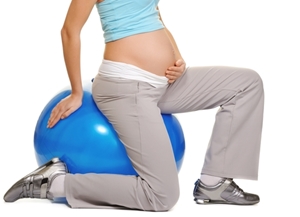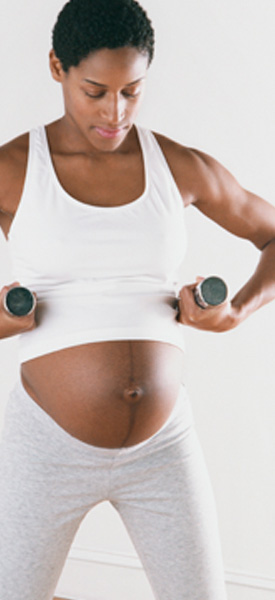

I found the postcard, written in 1945, in a dust-filled corner of my grandmother’s closet. It was a letter of encouragement—Bubby’s doctor urging my healthy, five months–pregnant grandmother to “keep your feet up, rest as much as possible.”
In the 60 years since Bubby’s first pregnancy, that advice has gone from passé to downright absurd. More than ever, pregnant women in good health are encouraged to keep active during the full nine months, assured it will make for less complicated pregnancies, shorter labors, and a faster return to their pre-pregnancy weight.
Into Action
“Even if a woman isn’t working out, most doctors would encourage her to at least start a walking program while she’s pregnant,” says Julie Bishop, M.D., an assistant professor of clinical orthopedics at The Ohio State University in Columbus, who specializes in sports medicine and the female athlete. “Exercise keeps weight gain down; it makes labor and delivery easier.”An athlete herself, Bishop spent the last night of her first pregnancy on the elliptical trainer. “Exercise is something I’ve always done and it was important for me to maintain [that],” she says.
The latest American College of Obstetrics and Gynecology guidelines side with Bishop. While previous recommendations encouraged sedentary women to stay so and suggested active women keep their heart rates under 140 beats per minute, the current advice tells “healthy pregnant women…to engage in at least 30 minutes of moderate exercise on most, if not all, days of the week.”
The heart-rate information, which was included to keep mothers-to-be from overheating, has been left off; the new test for overexertion? The ability to have a reasonable conversation. A seasoned athlete would therefore have a higher threshold, says Bishop.
This means that running—once a pregnancy taboo—is considered a sensible routine for someone who was already a runner. According to Gretchen Phillips, M.D., a Wyoming, MN–based general practitioner and radio host, easy jogging can be continued until the day of delivery.
Don’t Overdo It
Of course, you still need to proceed with caution. “Minimizing impact on joints, especially later in pregnancy, is important,” Phillips says. “As pregnancy advances, a hormone called relaxin is released, which causes ligaments and tendons to loosen and can leave ankles, knees, wrists, and elbows prone to injury.”
Many pregnant runners do feel discomfort and switch to walking or swimming as they progress in their pregnancy. Patrea Aeschliman, a certified strength and conditioning specialist in Indianapolis and the founder of Go Mom Fitness, had a difficult pregnancy and chose to replace her vigorous routine with a softer one.
“I did exercise with strength training and light cardio, even on the many days when I was vomiting,” Aeschliman says of her pregnancy workout plan. “For women who run long distances, it probably is perfectly safe to run during pregnancy, but I’m questioning whether it is comfortable or sensible.”
Read more: How to love your pregnant body
A Nod to Naysayers
For the gym-going mom-to-be, resistance may come from more than training. “There are so many people with the frame of mind that pregnancy is an illness and should be treated with kid gloves,” says Pilates instructor Suzanne Bowen of Franklin, TN, who is expecting her second child and recently released a prenatal fitness DVD.
For many pregnant women, this perception can make a trip to the gym feel like a trip to the zoo—with them as the main attraction. Bowen’s advice is simple: “Toughen up and do your research,” she says. “As long as you and your doctor or midwife agree about your workout—be it running, Pilates, boot camp—then listen to your body and decide up front that you will let ignorance roll off your back.”
Celebrity trainer Mike Monroe of New York City recently completed a prenatal fitness DVD with athlete Gabrielle Reece. He cautions that pregnancy is not the time to start a new workout regimen, but he also recognizes that it’s important for women to try to retain their fitness level. “Stay in line with what you were doing before,” he says.
For many moms who need exercise like they need to brush their teeth, this advice is more than welcome. “I notice a difference when I am not getting my workouts—and my kids do, too,” says Kathryn Sansone, a St. Louis–based personal trainer and mother of 10 who worked out throughout all of her pregnancies. “Even while pregnant, I still need to feel normal and be myself.”
Training With a Toddler?
For many women who were active during their first pregnancy, the presence of a needy 2-year-old can stymie their efforts in a second. It doesn’t have to, Bowen says. “Include the older child in what you like to do—running, walking, Pilates, yoga, dancing—they learn fast,” she says. “My little girl is 3 and loves to do Pilates and yoga. She does Tree Pose very well.”
Try classes for moms with kids—“mommy and me” yoga, outdoor stroller workouts, mom-and-baby fitness classes, music classes with dancing. Or switch to running or cycling; with the advances in jogging strollers (get tips and shop at joggermom.com
) and bicycle trailers, it can be very easy to bring your child along for the run, walk, or ride.
There’s also much exercise to be found in play, says Stacey Susini, a pregnant mother of one from Dallas, who does the monkey bars with her toddler son “wrapped around my legs dangling down.” Other mothers say they run through the sprinkler with their toddlers, dance in the living room, climb stairs towing their children, and pull the kids in wagons to get exercise.
— Sasha Brown-Worsham
Sasha is an avid runner and mother who kept running 10 miles a week until she was 36 weeks pregnant. Her writing has appeared in Self and Parents magazines.


Leave a Reply